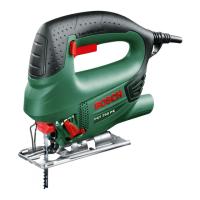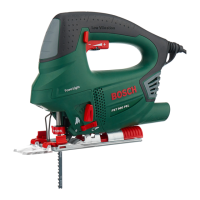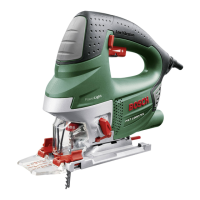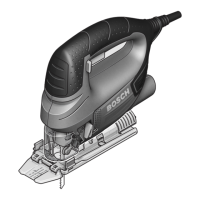English–3
2 609 000 112 • (03.10) T
Ensure that the mains voltage is correct!
The voltage of the power source must agree with the
value given on the nameplate of the machine. Ma-
chines designated for 230 V can also be operated with
220 V.
Switching On/Off
To put into operation, press the on-off switch 1 to
position I.
To switch off, press the on-off switch 1 to position 0.
■ Before any work on the machine itself, pull the
mains plug.
Sanding Plate Brake
An integrated sanding plate brake reduces the speed
when running at no load so that scoring is avoided
when placing the machine on the work piece.
A continuously increasing no-load speed over the
course of time indicates that the sanding plate brake is
worn and must be replaced by an authorized custom-
er service location for Bosch power tools.
Sanding Surfaces
Switch on the machine, place the complete sanding
plate on the surface to be worked and move the ma-
chine over the work piece with moderate pressure.
Ensure uniform sanding pressure. Less sanding pres-
sure increases the sanding capacity and protects the
machine and the sanding tool.
The removal performance and the sanding pattern are
determined essentially by the selection of the sanding
sheet (grain) and the application pressure.
Rough Sanding
Attach a sanding sheet with coarse grain (see Applica-
tion Table).
Apply only light sanding pressure to achieve increased
material removal.
Fine Sanding
Attach a sanding sheet with fine grain (see Application
Table).
With moderate pressure, move the machine in a circu-
lar pattern or alternately in lengthwise and crosswise
directions over the work piece.
Do not tilt the machine to avoid sanding through the
work piece (e.g. when sanding veneer).
After finishing the work, switch off the machine and lift
it from the work piece.
Application Table
The following table should be used only as a recom-
mendation.
The most suitable combination for the work to be per-
formed is best determined by practical trials.
Putting into Operation
Working Instructions
Material Grain
Rough sanding Fine sanding
Paint roughing 180 320
Paint touch-up 120 400
Paint removal 40 80
Softwood 40 240
Hardwood 60 320
Veneer 240 320
Aluminium 80 240
Steel 60 240
Rust removal
from steel 40 120
Stainless steel 120 240
Stone 80 200
